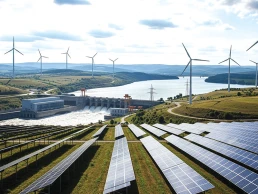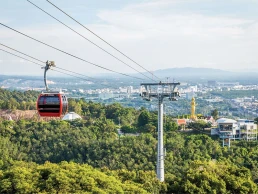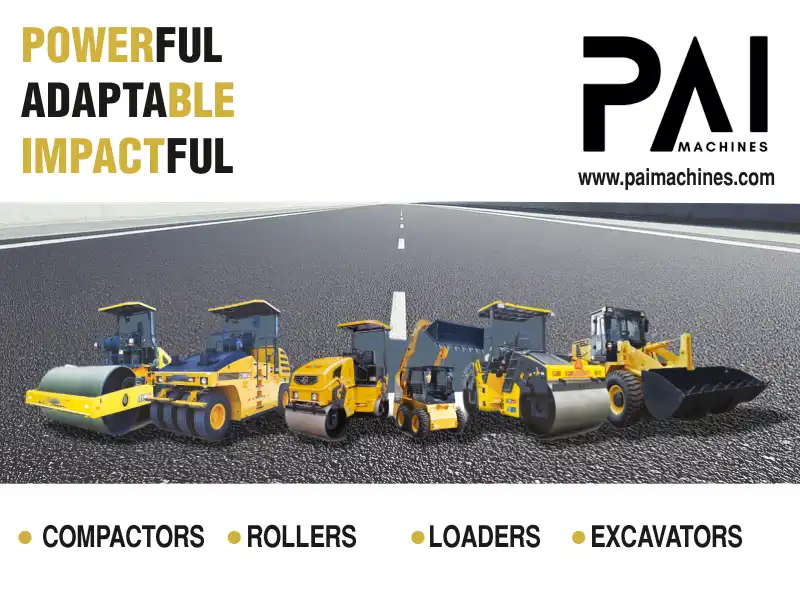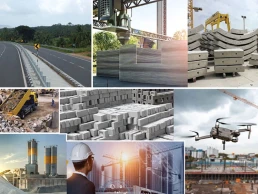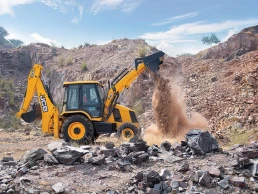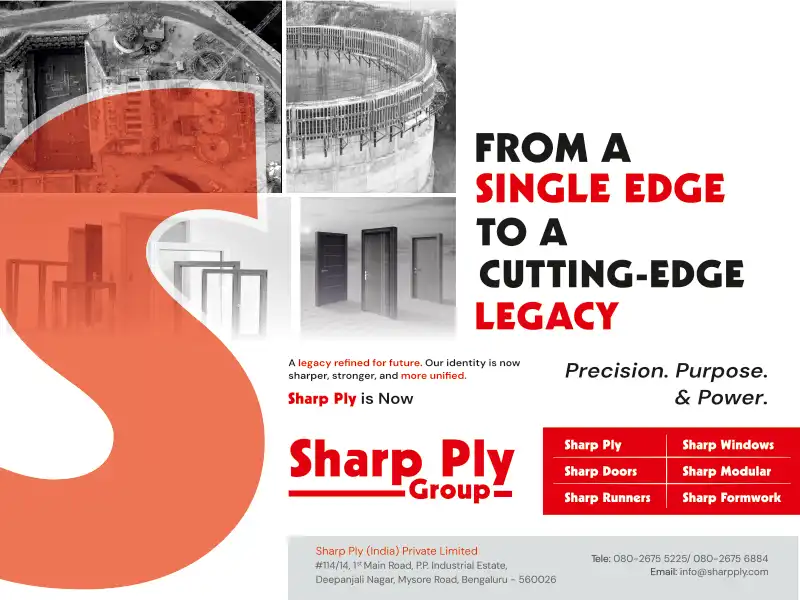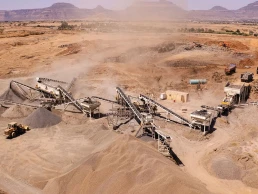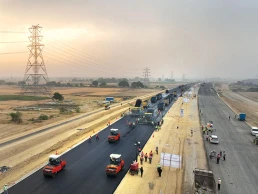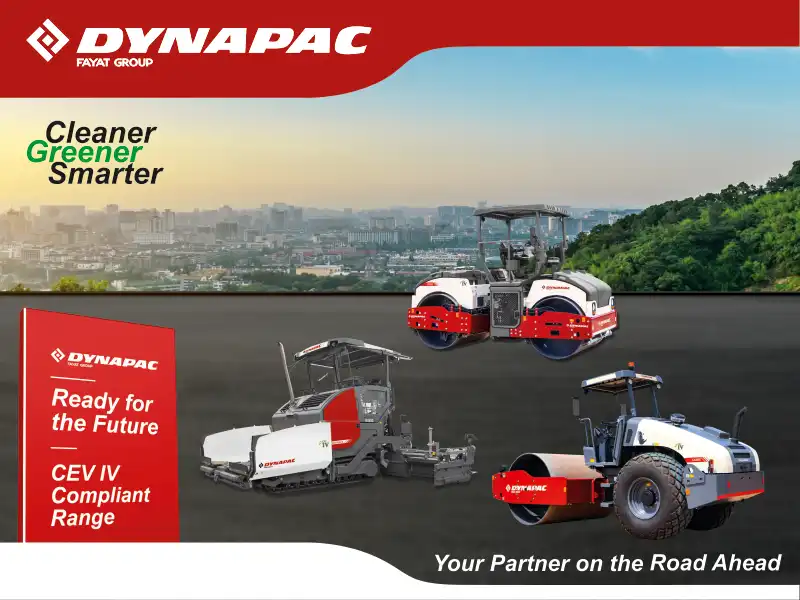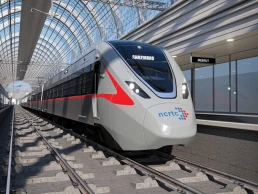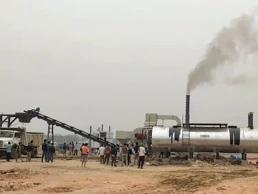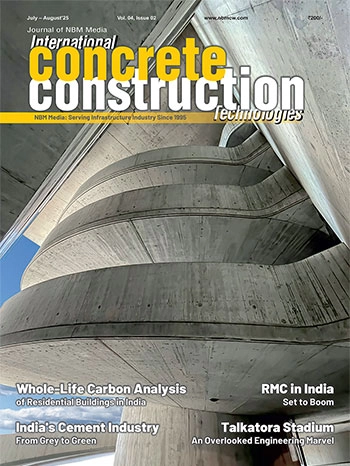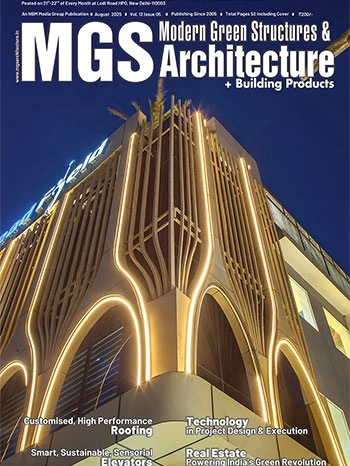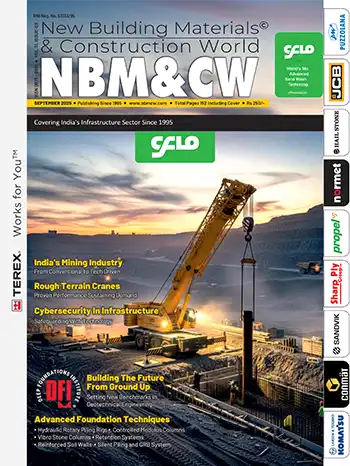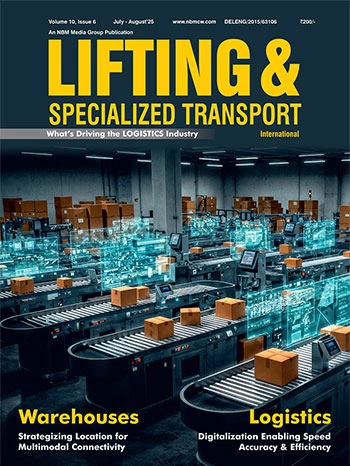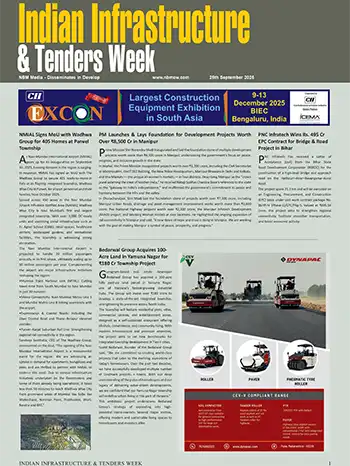The New Age of Tunnel Construction in India
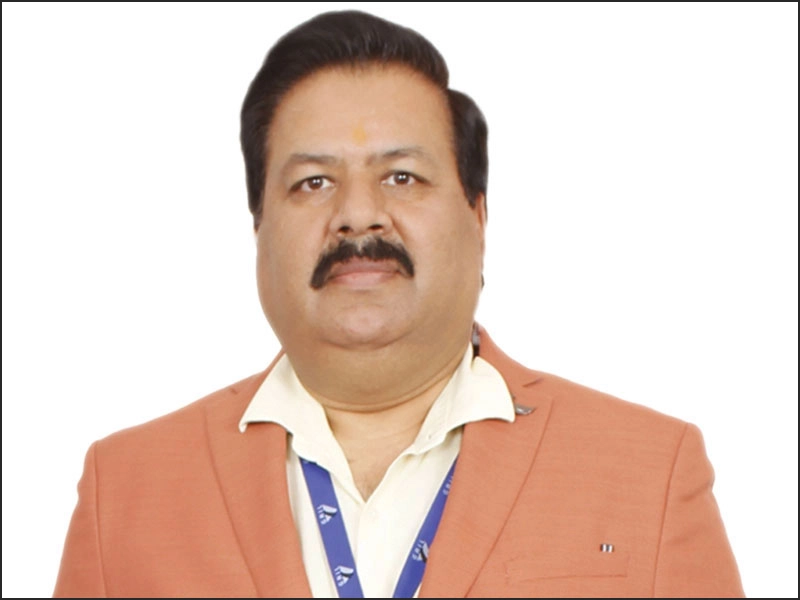
Dr. R.K. Khali, Vice President of the Tunnelling Association of India (TAI) and VP – Operations (Tunnelling & Hydro) at GR Infra, has been honoured with the prestigious ITA Fellow Title for his significant contributions to the tunnelling sector. A strong advocate of geotechnical risk management, digital twin technologies, and safety-integrated design, Dr. Khali highlights India’s shift from being a technology adopter to a global contributor of context-driven tunnelling practices. He shares insights on adaptive tunnelling, evolving contracting models, and India's growing role in the global underground construction landscape, with Maria R.
Congratulations on being awarded the title of Fellow of ITA in recognition of your outstanding contribution to the tunnelling industry. What does this global recognition mean to you personally and professionally, especially after 25 years of association with ITA-AITES?
Thank you. Receiving the ITA Fellow recognition is a deeply humbling honour that marks both a personal journey and a major milestone in my professional development. Personally, it is a moment of reflection on a path that began with curiosity and dedication to the tunnelling sector, often working in some of the most geologically challenging environments in India. Professionally, it signifies the increasing visibility and contribution of India to the global tunnelling community, where practices, technologies, and innovations from our region are now being shared and acknowledged on the world stage.
My association with ITA-AITES began in 1997 through the Tunnelling Association of India (TAI), where I started actively engaging with international practices and industry standards. In 2002, I had the opportunity to co-author and present a technical paper at the World Tunnel Congress (WTC), which marked my formal entry into global tunnelling dialogue. Over the years, I have consistently participated in General Assemblies, contributed to technical Working Groups, and advocated for harmonizing safety and sustainability benchmarks. This award strengthens my resolve to mentor the next generation, encourage innovation grounded in practical experience, and build bridges between countries, companies, and technical institutions. It underscores that sustained engagement, dialogue, and knowledge-sharing can bring long-term value to the underground construction fraternity and to the broader field of infrastructure development.
Looking back on your journey at ITA WTC, which began with presenting a technical paper in 2002 and evolved into becoming a key contributor to the tunnelling industry, what milestones have most shaped your professional growth and vision for the sector?
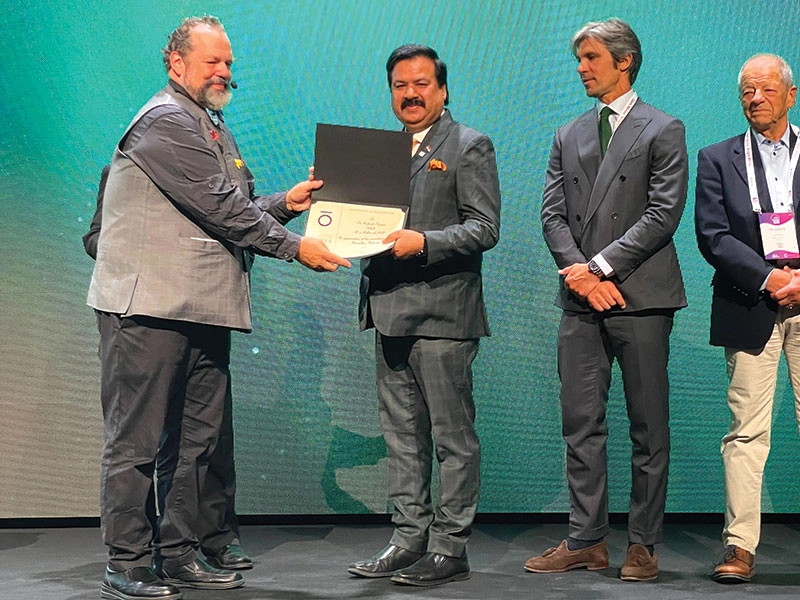
My journey with ITA WTC has been defined by several formative milestones. Presenting a co-authored technical paper in 2002 gave me an early window into how global tunnelling problems are analysed, shared, and solved through multidisciplinary collaboration. The experience exposed me to not only cutting-edge technologies but also the global language of tunnelling that bridges national and regional practices.
A major milestone was my active role in ITA Working Group 5 on Health and Safety. This platform enabled collaborative problem-solving on universal safety challenges such as ventilation, rockfall prevention, and emergency preparedness. Exposure to this culture of structured safety deeply influenced how I approach workforce welfare in tunnel construction.
Visiting international tunnelling projects, from metro systems in Europe to deep-bore hydro tunnels in Asia-Pacific, further shaped my outlook. I began seeing tunnelling not just as an engineering task but as a public service—one that requires empathy for urban life, sensitivity to the environment, and accountability to future generations. These cumulative experiences shaped a vision rooted in resilience, adaptation, and purpose-driven leadership. I also realized the power of mentorship and began devoting more time to developing young tunnelling professionals through forums, paper reviews, and direct training engagements.
You've been actively involved with Working Group 5 on Health and Safety since 2010. In your view, how has the approach to safety in tunnelling evolved over the years, and what role has ITA played in driving these changes globally?
The evolution of safety in tunnelling over the past two decades has been transformative. What was once largely reactive—focused on incident reporting and compliance enforcement—has now matured into a proactive, integrated culture of risk anticipation and behavioural accountability.
In earlier phases, safety was often considered a function of site supervision alone. Today, it begins at the design stage, with provisions for tunnel evacuation, fire suppression, ventilation, and even psychological well-being built into the planning process. Safety has become a cross-functional responsibility, owned not just by HSE officers but by engineers, procurement teams, and senior leadership.
The ITA’s Working Group 5 (Health & Safety), with which I have been associated since 2010, has been instrumental in this shift. The Group has:
- Introduced global guidelines on chemical exposure thresholds, underground fire response protocols, and rockfall hazard assessment.
- Influenced the adoption of design-for-safety practices, including clearances for escape routes, refuge chambers, and fire-resistant linings.
- Pioneered work on ergonomics in confined spaces and mental health awareness in isolated tunnelling environments—areas often overlooked in the past.
My contribution within WG5 has focused on contextualizing these frameworks for Indian project realities, where geology is often unpredictable, the workforce predominantly labour-intensive, and access to high-end automation may be limited.
Some notable efforts include:
- Piloting modular safety training units in multiple Indian languages, using pictograms and role-play to drive comprehension.
- Promoting digital monitoring systems, such as sensor-based gas detection and real-time deformation tracking, which allow for early warnings in geotechnically vulnerable zones.
- Advocating for peer-to-peer safety communication models, where workers are trained to not only follow procedures but to mentor their colleagues—building a culture of mutual accountability.
These efforts are starting to show results. In projects which I have overseen, there has been a noticeable decline in preventable incidents, improved emergency response times, and stronger worker engagement in safety briefings and toolbox talks.
In essence, ITA’s leadership has helped reframe safety as a shared value—not just a regulatory requirement. This global-to-local translation is vital in ensuring that every tunnelling worker, regardless of geography, returns home safe every day.
With major tunnel and hydro projects underway across India, what key operational or technological shifts do you see as critical for improving efficiency, safety, and project quality in the sector?
India’s underground construction ecosystem is experiencing an unprecedented scale-up, with multiple tunnel and hydropower schemes underway across diverse geologies. To meet the evolving demands of this landscape, several critical operational and technological shifts are taking shape:
- Digital Integration Across Lifecycle: Technologies like BIM (Building Information Modelling), LiDAR-based terrain analysis, and GIS are now foundational tools. At the design stage, they enhance alignment precision, while during construction, digital twins simulate structural responses to stress, enabling real-time scenario planning. This results in fewer change orders, enhanced safety buffers, and better control over interfaces.
- Hybrid Construction Methodologies: Indian projects especially in the Himalayan and peninsular zones often require a mix of excavation techniques. For example, the Dibang project combines Drill & Blast in high-strength rock with NATM in squeezing zones. The ability to switch seamlessly across techniques without delays is a hallmark of operational maturity.
- Localization of Equipment and Materials: A concerted push is underway to manufacture TBM cutters, precast segment moulds, and rock support additives domestically. This reduces lead times, improves cost control, and enhances responsiveness during equipment breakdowns or design changes—especially crucial in remote sites with narrow logistics windows.
- Workforce Upskilling and Safety Culture: Simulation-based training modules are now being developed in collaboration with technical institutes, focusing on high-risk scenarios like tunnel collapse, gas inflow, or TBM entrapment. These are being integrated into site-level onboarding, enabling proactive safety awareness from the first day of deployment.
- AI-Driven Predictive Planning: Artificial Intelligence is increasingly used to optimize equipment utilization, forecast TBM cutter wear, and schedule maintenance. These systems also support automated progress tracking and generate alerts when deviations from planned parameters occur—vital for inaccessible or high-altitude work zones.
Together, these shifts are not just modernizing Indian tunnelling—they are making it smarter, safer, and more self-reliant. This holistic transformation lays the groundwork for achieving global benchmarks in process excellence, cost efficiency, and sustainability.
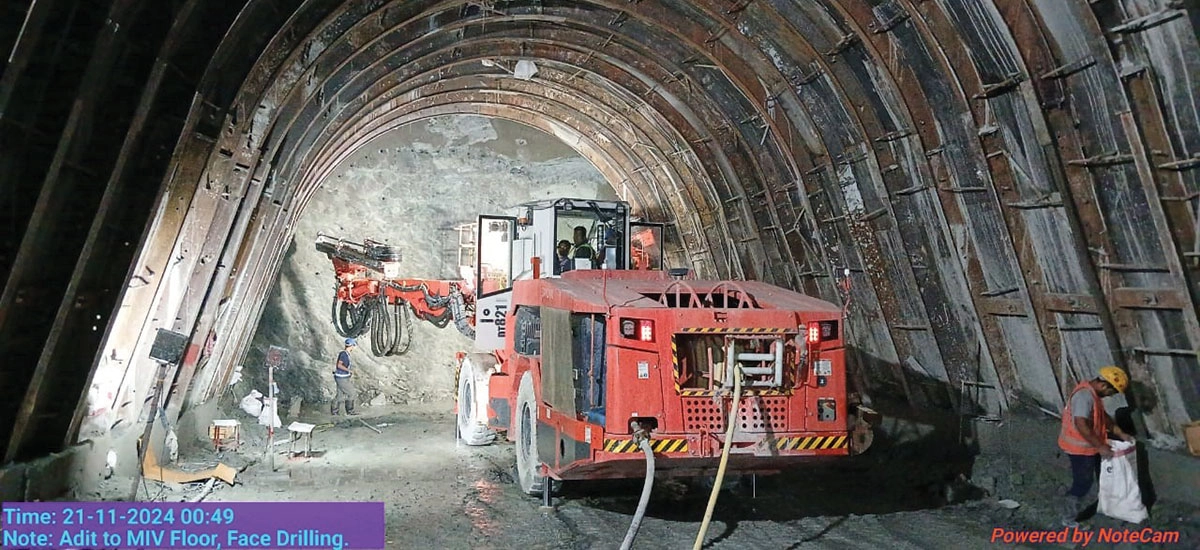
As someone closely involved in hydropower tunnelling, what role do you see hydropower playing in India’s renewable energy mix, and what are the key engineering or execution challenges in developing large-scale hydro projects in complex terrains?
Hydropower plays a pivotal role in India’s journey toward a sustainable and balanced energy mix. While solar and wind energy continue to scale, they remain inherently intermittent. Hydropower—and more specifically, pumped storage hydro—acts as the stabilizing backbone by providing both base-load capacity and peak load flexibility.
Projects like the Tehri Pumped Storage Plant (1000 MW) exemplify this. Here, the Tail Race Tunnels (TRTs) serve dual functions, operating as Headrace Tunnels during pumping and as TRTs during generation. Similarly, the outfall structures act as intake structures in reverse flow mode. This reversible hydraulic configuration not only improves energy efficiency but also exemplifies how underground infrastructure can be engineered for multi-functional utility—particularly in constrained mountainous settings.
However, developing large-scale hydropower in India, particularly in Himalayan regions, presents a range of complex engineering and logistical challenges:
- Challenging Geology: High overburden zones, shear zones, fault lines, and squeezing ground are common. Geological unpredictability demands continuous real-time monitoring through extensometers, piezometers, and convergence meters, with excavation and support schemes updated dynamically.
- Remote Accessibility: Many sites lie deep within narrow river valleys or forested zones with limited road access. Mobilization of heavy machinery often requires specially constructed access roads, ropeways, or even helicopter support, adding to both cost and time.
- Environmental and Social Sensitivity: Tunnel portals, adits, muck disposal areas, and access roads must be carefully planned to avoid ecologically sensitive zones, minimize deforestation, and reduce disturbance to local communities. Environmental clearances can be time-consuming and call for multi-agency coordination.
- Climatic Limitations: With monsoon rains, snowbound winters, and landslides disrupting schedules, projects face short working seasons. This necessitates modular and parallelized construction, often with multiple faces and 24x7 working cycles.
- Safety and Workforce Challenges: High-altitude tunnelling increases the risk of fatigue, respiratory stress, and logistical isolation for the workforce. Robust medical support systems, ergonomic planning, and hazard anticipation training are essential.
To tackle these challenges, we’ve implemented:
- Robotic shotcreting arms and remotely operated equipment to reduce human exposure in hazardous zones.
- Modular concreting systems to streamline tunnel lining and invert casting.
- Centralized digital dashboards for geotechnical monitoring and shift coordination across portals.
- Real-time feedback loops between instrumentation and excavation strategy enabling what we call "adaptive tunnelling."
Looking forward, hydropower will remain integral not only for India’s clean energy goals, but also for water resource management and grid resilience. Scaling such projects sustainably will require deeper integration of tunnelling technology, environmental science, and project management discipline.
Delivering addresses at the ITA General Assembly eight times is a rare distinction. How have these global engagements helped highlight India’s contributions and potential in the international tunnelling community?
Delivering eight addresses at the ITA General Assembly has been both a professional honour and a strategic responsibility. These sessions have served as a unique platform to bring India’s tunnelling innovations, resilience, and adaptive methodologies to the global forefront—often bridging the gap between emerging market challenges and international best practices. Through these engagements, I have consistently highlighted major Indian tunnel projects that exemplify how complex conditions can be turned into engineering opportunities. For instance:
- The Dibang Multipurpose Project demonstrates advanced cavern construction under high seismicity and rainfall.
- The Tehri Pumped Storage Plant showcases reversible hydraulic systems, where Tail Race Tunnels double as Headrace Tunnels—a design rarely executed at such scale.
- At Tapovan Vishnugad, we implemented sequential excavation adaptations in highly squeezing ground, integrating real-time data into decision loops.
- The Adanigarh–Purana Cuttack Rail Tunnels feature a blend of NATM and cut-and-cover reimagined based on low cover and environmental constraints—demonstrating agility in execution strategy.
These global presentations have shifted perception. India is no longer viewed merely as a recipient of technology, but as a contributor of context-rich, scalable engineering practices tailored to diverse geologies and societal conditions. They’ve helped demystify Himalayan tunnelling challenges and positioned Indian solutions—like modular invert systems, multilingual safety training, and hybrid excavation methods—as globally relevant.
On a collaborative front, these sessions have facilitated:
- Joint research dialogues on tunnel safety and environmental compliance.
- Technology pilot projects involving instrumentation and AI-driven monitoring.
- Peer exchanges that have shaped cross-border mentoring initiatives for young tunnelling professionals.
Personally, these opportunities have reinforced my belief that global platforms like ITA must integrate more voices from complex geographies. When nations like India speak of tunnelling under uncertain geology, short working seasons, and community-sensitive zones, it broadens the collective understanding of underground infrastructure beyond traditional benchmarks.
The real impact lies not just in visibility, but in influencing global codes, working group priorities, and inter-country cooperation that can help address the shared challenges of the tunnelling community.
Tunnelling is not merely construction beneath the surface; it is engineering beneath uncertainty.
As Vice President of the Tunnelling Association of India (TAI), how are you driving collaboration between government, industry, and academia to promote sustainable tunnelling practices and talent development? Additionally, how can TAI further align with ITA’s global Working Groups to develop localized expert panels for India’s unique geotechnical challenges?
Sustainable tunnelling in India cannot be achieved in isolation—it must be cultivated through meaningful synergy across government, industry, and academia. As Vice President of TAI, I have prioritized establishing institutional mechanisms that transform this idea into a working reality.
Government Collaboration: TAI has actively supported government ministries and regulatory bodies in formulating tunnel-specific standards related to safety systems, ventilation design, waterproofing, and emergency egress protocols. Our members have contributed directly to draft national codes—many of which are now under final review. These recommendations are not theoretical; they’re shaped by a dual lens: international benchmarks from ITA, and practical experience gained from Himalayan and metro tunnelling across India.
Industry Engagement: We have positioned TAI as a technical interface for the industry. Through multi-stakeholder technical reviews, we’ve encouraged contractors, consultants, and OEMs to adopt forward-looking approaches—ranging from energy-efficient MEP design to environmental restoration planning post-excavation. One of our key initiatives is promoting indigenous development of TBM cutter heads and NATM lattice support tailored for mixed-face ground—strengthening India’s self-reliance while reducing project delays due to import logistics.
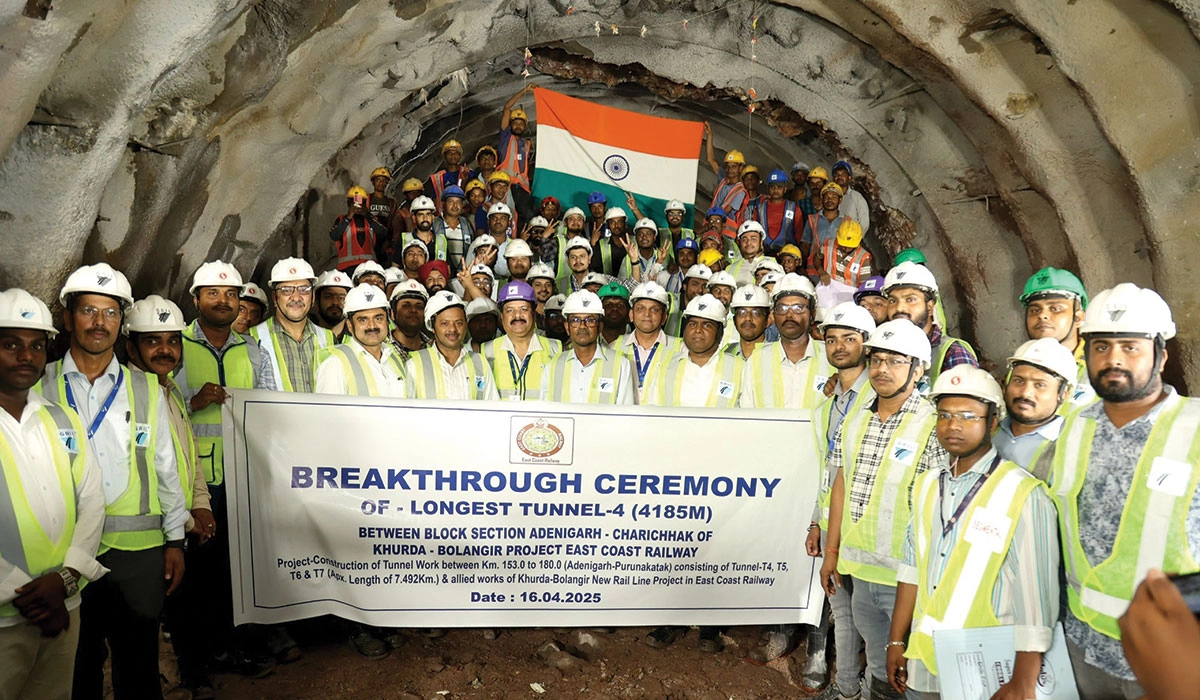
Academic Partnership: TAI has worked closely with premier academic institutes such as IIT Roorkee, IIT Delhi, IIT Jammu, IIT Mandi, MITWPU Pune and NIT Srinagar to institutionalize tunnelling education. We’ve helped establish Tunnelling and Underground Structure Cells (TUSC) where students are introduced to real project data sets, 3D modelling platforms, and risk-based design methods. Through faculty exchange programs, industry mentorships, and joint workshops on digital twins, instrumentation, and geotechnical analytics, we are bridging the gap between classroom theory and field execution. Seeing the success above academic associations, now Delhi Technological University is also starting M. Tech course in tunnelling and willing to work closely with TAI.
Global Integration with ITA Working Groups: We are not only enhancing Indian participation in ITA Working Groups, but also aligning their international deliverables to our local context. For example:
- Under ITA WG2 (Research): We’ve launched focused expert panels for Himalayan tunnelling, tropical groundwater impact studies, and long-term thermal performance in deep rock tunnels.
- Under WG5 (Health & Safety): We’ve created region-specific safety training content in local languages, accounting for India’s labour-intensive tunnelling environment and complex emergency response logistics in remote or high-altitude sites.
These localized expert panels serve dual functions
- As Translators – They adapt ITA's high-level guidelines into actionable strategies suited for Indian projects—be it a congested metro corridor or a remote hydropower tunnel.
- As Amplifiers – They broadcast India’s practical innovations—like adaptive NATM in low-cover zones or community-based early warning systems—back into ITA forums, contributing to global knowledge sharing.
Our long-term goal is to ensure that every Indian tunnelling initiative is globally benchmarked and locally optimized. Through these strategic collaborations, we are not only building safer, more sustainable tunnels—but also a more future-ready tunnelling ecosystem for the country.
Safety has become a cross-functional responsibility, owned not just by HSE officers but by engineers, procurement teams, and senior leadership.
As VP–Operations for Tunnelling & Hydro at GR Infra, what have been some of the most complex geotechnical or geological challenges your team has encountered recently, and what innovative design and execution strategies were deployed to address them?
Two of our recent projects exemplify the kinds of complex geotechnical and logistical challenges we regularly face—and how we respond with practical innovation tailored to Indian conditions.
Dibang Multipurpose Project (Arunachal Pradesh)
This is India’s largest hydropower project currently under execution, located deep in the Eastern Himalayas—an area characterized by intense seismicity, high rainfall, and extreme topographical constraints. The project involves extensive underground works, including large-diameter headrace tunnels, underground powerhouses, and vertical shafts under overburden exceeding 800 meters in some zones.
Challenges we encountered included
- Highly variable rock formations, transitioning from jointed gneiss to sheared quartzite and phyllite with fault zones.
- Frequent slope failures near adits and portals, especially during monsoon due to fragile vegetation and soil.
- Heavy groundwater inflow during tunnelling, threatening invert heave and deforming the primary support in soft stretches.
Our mitigation strategies were multi-layered
- We deployed real-time instrumentation—MPBX, piezometers, convergence meters—feeding data to a centralized dashboard for live monitoring.
- Pre-excavation grouting curtains and targeted contact grouting were executed to reduce water ingress and seal fractured zones.
- Use of Piperoofs with lattice girders and shotcrete helped manage squeezing ground behavior and minimized shotcrete rebound in moist areas.
- Sequential excavation in short rounds with rapid support installation enabled safe advance through unpredictable geology.
- Slope stabilization around working faces was handled with emergency soil nailing, berming, and reinforced shotcrete.
Logistically, this project demanded aerial material delivery, modular camps, and round-the-clock coordination across three shifts—reinforcing the value of our in-house agility and real-time design adaptation.
Adanigarh–Purana Cuttack Railway Tunnel Project (Odisha)
This project features four tunnels (T-4 to T-7), passing through mixed geology and low overburden stretches. Tunnel T-4, over 4.1 km in length, also includes a 700m parallel escape tunnel.
A unique challenge arose in Tunnel T-7, where a 100-meter stretch under shallow overburden was originally planned for cut-and-cover construction. However, due to ecological and resettlement sensitivities, we opted to convert this section to a fully underground alignment using NATM.
Key interventions included
- Central drift excavation supported by double-layer shotcrete and lattice girders to preserve crown integrity.
- Continuous convergence measurement allowed dynamic updates to support design.
- Efficient muck handling and portal traffic planning helped us navigate narrow valley constraints without disturbing surface features.
Today, all tunnels have been daylighted, and civil works in T-5 and T-6 are complete. MEP and trackworks are advancing as scheduled, while the remaining cut-and-cover section of T-4 (approx. 1.5 km) is progressing with micro-blasting and carefully benched excavation.
These projects reinforce three foundational principles of our tunnelling approach:
- Adaptive Engineering: Designs must evolve in response to geological realities. Flexibility is our asset.
- Data-Driven Execution: Instrumentation isn’t a formality—it guides our daily field decisions.
- Integrated Management: Engineering must be seamlessly aligned with safety, environment, logistics, and stakeholder needs.
India’s tunnelling future will be shaped by how effectively we embed resilience into each layer—from rock classification to supply chain logistics. At GR Infra, our vision is to continuously blend local insight with global best practices to build underground infrastructure that is not only efficient but enduring.
India is no longer just a recipient of technology but a contributor of context-rich, scalable engineering practices.
With TAI taking the lead in proposing an ITA Asia–Pacific Regional Chapter, how do you envision this platform strengthening regional cooperation, and what priorities should be addressed in its early phases to ensure inclusive growth and knowledge exchange across member countries?
The Asia–Pacific region presents a remarkable diversity of tunnelling challenges—from high-altitude hydro tunnels in the Himalayas to soft-ground metro systems in Southeast Asia and extensive urban rail corridors in East Asia. Yet, regional collaboration has largely remained informal and fragmented. The proposed ITA Asia–Pacific Chapter aims to change that by creating a dedicated platform for shared learning, peer support, and localized innovation. In the initial phase, I see four core priorities:
- Cross-border capacity building through joint technical workshops, site visits, and multilingual digital training programs tailored to regional conditions.
- Standardization of benchmarks in areas like tunnel safety, groundwater control, and seismic resilience to improve quality and consistency across projects.
- Formation of region-specific Working Cells under ITA’s umbrella—focusing on tropical tunnelling, high-density urban shafts, and risk mitigation in high-altitude and seismic zones.
- Inclusive participation, especially encouraging smaller and developing countries like Nepal, Vietnam, or Bangladesh to engage actively through mentorship programs and subsidized knowledge-sharing initiatives.
India, through TAI, is uniquely positioned to act as a regional knowledge hub. With our experience in large-scale hydro, hybrid tunnelling methodologies, and digital integration in complex terrains, we can contribute both leadership and learnings. The Asia–Pacific Chapter can democratize access to global best practices, reduce the learning curve, and foster resilience through collective expertise—ensuring that every country, regardless of its stage of development, has a seat at the table and the tools to build safely and sustainably.
How are advanced technologies like BIM, digital monitoring, and AI transforming tunnel construction in terms of safety, precision, and overall project efficiency? What key shifts do you foresee in the near future?
The integration of advanced digital technologies is fundamentally transforming how tunnels are designed, constructed, and managed. In India and globally, we are witnessing a shift from reactive project execution to a predictive and data-informed approach that significantly enhances safety, precision, and overall operational efficiency.
Building Information Modelling (BIM) has matured from 3D visualization to integrated 5D and 6D platforms, enabling real-time cost and sustainability assessments alongside detailed construction sequencing. At GR Infra, we are deploying BIM across the full project lifecycle—from early clash detection to material tracking and post-construction asset management. This allows us to anticipate issues well before they occur and respond with agility in the field.
Digital monitoring systems have also advanced significantly. Our tunnel projects now use an integrated array of instruments—such as extensometers, piezometers, convergence meters, and gas sensors—that feed real-time data into cloud-based dashboards. These systems enable proactive decision-making, especially in high-risk geologies like the Himalayan belt. For example, at Dibang and Tehri PSP, such monitoring allowed us to adapt excavation sequences and support systems based on real-time deformation readings.
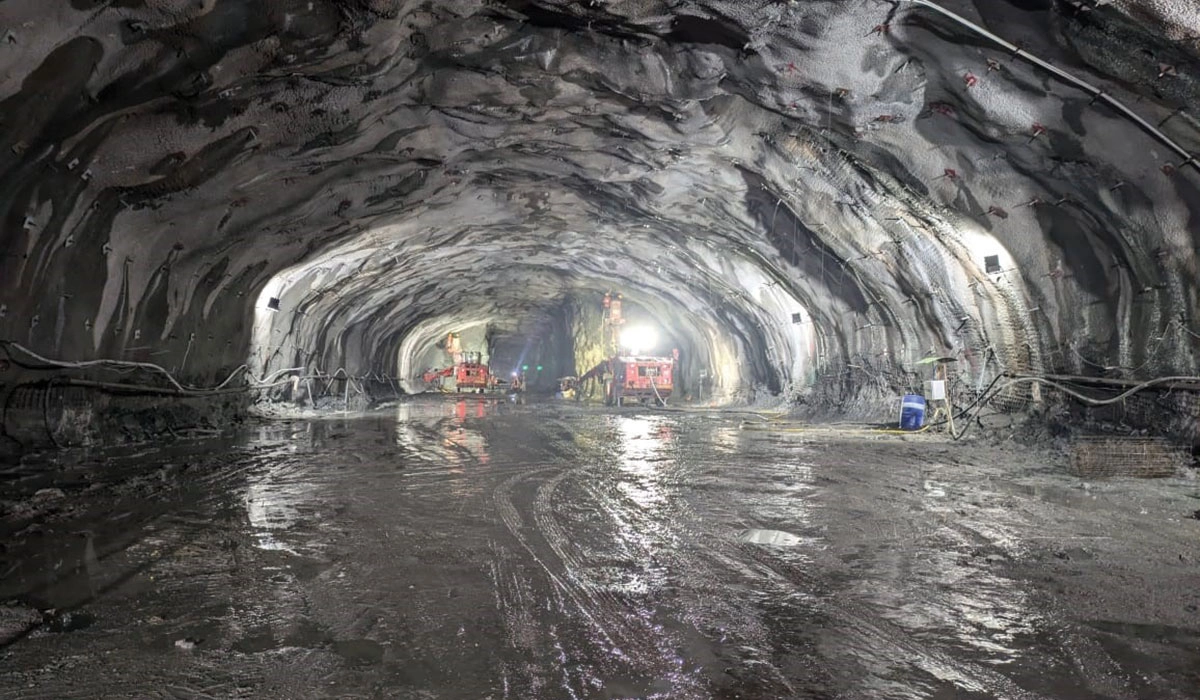
Artificial Intelligence (AI) is revolutionizing predictive planning. AI-based models are helping us assess TBM cutter wear, forecast geological anomalies from historical probe drilling data, and even optimize shift cycles based on productivity patterns. These tools reduce downtime, improve machine utilization, and enhance worker safety.
We are also piloting Digital Twins for critical infrastructure components like shafts and underground caverns. These virtual replicas allow us to simulate stress redistribution, monitor lining behaviour, and plan maintenance proactively. Additionally, drone-based inspections are being used in inaccessible crown sections and unventilated zones, providing visual and thermal mapping without exposing personnel to risk.
Looking forward, I see four major shifts shaping the near future of tunnelling:
- AI-integrated TBM navigation, enabling adaptive steering in mixed ground conditions.
- Predictive tunnel health diagnostics, akin to real-time condition monitoring in aerospace.
- Cloud-based asset registries, consolidating tunnel data for national infrastructure planning and O&M.
- Wider adoption of robotics in tasks like automated shotcreting, bolting, and muck removal—especially useful in confined or hazardous environments.
These advances are not merely innovations—they are catalysts for transforming tunnelling into a smarter, safer, and more accountable domain. As India scales up its underground infrastructure, these technologies will be central to delivering world-class projects on time, within budget, and with uncompromising safety.
Being conferred the ITA Fellow Award is not just a personal honour—it is a recognition of India’s growing expertise, a reflection of our collaborative progress, and a testament to our contribution to the global tunnelling community.
With India’s tunnelling landscape evolving rapidly, how do you determine the most suitable tunnelling method—be it NATM, TBM, or Drill & Blast—for varied terrains and project specifications?
Tunnelling method selection is never a one-size-fits-all decision. It is a calibrated blend of geology, project context, construction philosophy, and risk tolerance. In practice, the choice is informed by a multi-layered assessment that begins with a thorough Geological Baseline Report (GBR) and evolves through constructability reviews, environmental clearances, and resource planning. Let me break it down by method:
- Drill & Blast (D&B) remains highly effective in competent rock formations with low overburden, particularly where tunnel lengths are shorter or where mobilizing mechanized equipment like TBMs is logistically or economically unviable. D&B also provides high flexibility in complex alignments and during portal or access tunnel construction.
- Tunnel Boring Machines (TBMs) are ideal for long drives in consistent strata, especially in urban settings, under rivers, or through high water pressure zones, where minimal surface disturbance and faster rates of advance are crucial. TBMs also offer better environmental control and worker safety under controlled pressurized conditions.
- New Austrian Tunnelling Method (NATM) is indispensable in mixed geology, squeezing ground, or when working under high overburden in areas like the Himalayas. Its observational approach allows real-time response to changing rock mass behavior and is best suited for unpredictable conditions, where adaptability is critical.
Increasingly, Indian projects demand hybrid excavation strategies. For example, in the Dibang Multipurpose Project, we began with conventional D&B and shifted to NATM with lattice girders and shotcrete as we encountered squeezing zones. At Tehri PSP, we designed transition zones to accommodate modifications in excavation class and support systems based on real-time instrumentation feedback—enabling us to switch between methods without disrupting the construction flow.
We’ve even seen instances where TBM was used for main tunnel drives while NATM or D&B was adopted for junctions, caverns, or fault crossings. This trend toward method convergence—enabled by modular equipment, skilled multidisciplinary teams, and robust digital instrumentation—is redefining tunnelling practices across India.
Ultimately, the key is adaptive execution. The most successful projects are those that maintain method flexibility, integrate real-time data from site instrumentation, and are supported by agile logistics and engineering foresight. Future tunnelling in India will increasingly rely on this adaptive, hybrid approach to deliver infrastructure that is resilient, safe, and on schedule.
Your journey and this award are a source of inspiration to many. What message would you like to share with emerging tunnelling professionals in India and globally on leveraging international platforms like ITA for growth, research, and leadership?
To the next generation of tunnelling professionals—engineers, geologists, planners, safety experts—I offer this message: Tunnelling is not merely construction beneath the surface; it is engineering beneath uncertainty. It calls for quiet resolve, technical depth, and the ability to lead without always being seen. The challenges are immense—variable geology, confined environments, shifting alignments—but so are the rewards. You become part of something enduring.
International platforms like the International Tunnelling and Underground Space Association (ITA) are more than professional networks; they are gateways to global learning, mentorship, and impact. I began my engagement in 2002 with a technical paper. Today, that single step has grown into decades of collaboration, committee leadership, and shared advocacy for safety and innovation. Here’s my guidance:
- Start early and stay curious. Attend WTC sessions, join technical working groups (like WG5 on Health & Safety), and contribute case studies. Every experience you share—whether from a Himalayan shaft or an urban metro tunnel—adds to global understanding.
- Balance local intuition with global best practices. Know your ground conditions intimately, but be open to global advancements like digital twins, AI-driven TBM steering, or advanced grouting solutions.
- Focus on safety and sustainability. These are no longer buzzwords; they are prerequisites for leadership. Lead by example in your daily work.
- Mentorship matters. Seek mentors and become one. Share your experiences, challenge conventional thinking. Leadership is not conferred—it is earned through persistence, credibility, and the ability to uplift others.
Ultimately, growth in this field isn’t linear—it’s layered, much like the ground we excavate. Platforms like the ITA don’t just amplify voices; they transform careers, connect nations, and set the stage for meaningful change. Use them well—not just to grow professionally, but to help shape the future of underground development with purpose, precision, and pride.

































